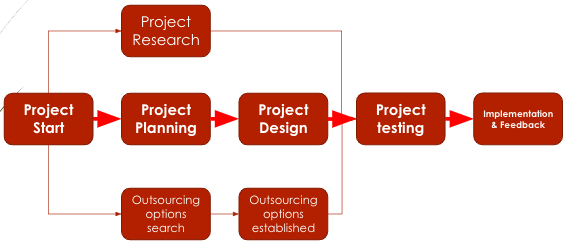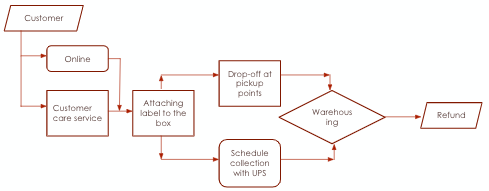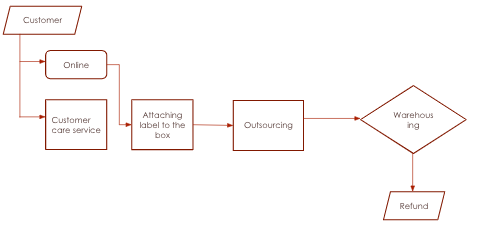Project Description
The aim of the project is to integrate technology advancement and outsourcing as two aspects of process improvement into Apple’s process chains. With the help of process optimization, the business will receive top-notch services through outsourcing. The Apple supply chain, where diverse outsourcing fosters value development, serves as evidence of this. The project’s reorganization of process chains will help shorten the period of time it takes to process refunds. Since the return policy will take less time and money, the future process will be effective. To make it easier to find problems, the process improvement project will be carried out in stages. Customers typically think about the after-sales services after acquiring the goods, and this will give Apple Company a long-term competitive advantage. Presently, returning faulty goods to Apple Company entails a number of steps, which subsequently leads to unnecessary costs and time use; hence, a process optimization strategy is required in order to advance the procedure. The company provides the client with a time frame of 14 days to analyze the product and return it within the set period. The first step to be considered and reviewed for effectiveness, cost, and effects on profit and the reputation of Apple products is outsourcing.
Project Management Charts
Critical Path Chart

Considering project management charts, it is obligatory to state that Critical Path and Gantt Chart methods were incorporated for the systematization of the elaboration processes. The key finding from the research is that using Gantt Charts and Critical Path Evaluation flow charts synergistically enhances project management and technology transmission strategic planning and design (Lee & Shvetsova, 2019). It has been observed that the employment of project-management methodologies is beneficial for research and technology patterns, as well as for processes of optimization and reorganization (Lee & Shvetsova, 2019). Hence, as per the Critical Path chart, it is feasible to emphasize the essential steps of the process: launching, planning, design, testing, implementation, and feedback.
Gantt Chart

The second project management chart that was selected in order to illustrate the practical aspects of the project development was the Gantt Chart. Technology exchange initiatives and project management clarifications benefit significantly from the use of Gantt charts and Critical Path Analysis data flow charts (Lee & Shvetsova, 2019). Connectivity schematics’ critical routes and functional reserves aid in streamlining the technical assistance in strategic planning (Lee & Shvetsova, 2019). Utilizing the concepts of Gantt Chart elaboration, it was possible to divide the project into separate crucial parts and assign specific time frames and deadlines for monitoring and overseeing activities. In fact, the concrete steps include planning, research, design, implementation, and follow-up. The research, design, and implementation stages of the project were assessed as the most time-consuming.
Improved Process Flowchart
Initial variant

The process of returning products to Apple Company involves a series of steps that are time-consuming. The company provides the client with a time frame of 14 days to analyze the product and return it within the set period. In general, after 14 days have expired, product returning is not allowed. Furthermore, according to the information from the Week 1 assignment, the company charges the client a 25% fee for an open box per unit and 15% per unit for the returned closed boxes. The cost, return, and refund time frame creates negative feedback regarding Apple products; hence, the need for improvements since customer satisfaction is critical. It is feasible to emphasize the prevalence of unnecessary procedure actions that have to be restructured and optimized.
Improved flowchart

It is crucial for the company to minimize the time taken when returning products and refunds to promote the relationship between the company and the customers. The return policy can potentially have a significant effect on gaining a competitive advantage. This provides crucial information when clients want to purchase Apple products since it helps them evaluate the risks associated with them. In this case, it is possible to state that with a reduction of extra process stages and general procedure optimization, the process will be performed more efficiently with cost-reduction and improved decision-making positive consequences.
Meeting Cadence, Rhythm, and Timing
According to the time span and functional scope of activity of the project with its separate tasks that have to be completed during a one-week period, two types of meeting cadence and timing are required. Timing that is optimal can result in rapid reactions to shifting external conditions and customer requirements as well as greater project team effectiveness (Cooper & Sommer, 2018). In general, the project development group should be concentrated on arranging both daily and weekly meetings. Weekly meetings are necessary to overview and analyze the results of the completion of a specific stage of the process, whereas daily meetings would provide relevant updates.
Metrics to Measure Project Success
Project management parameters and Key Performance Indicators (KPIs) can be used to systematically assist the group in achieving the operational and strategic objectives for succeeding in project management. Although demonstrating value is crucial, forward-thinking planning and monitoring prioritize performance enhancement. KPIs for project management are essential since they make it possible to track the development of operations, and it is imperative to ensure that they correlate to certain project stages (Cruz Villazón et al., 2020). As an illustration of pertinent metrics, if the permitted slack time period is postponing the accomplishment of subsequent tasks, it is feasible to change the slack period. Consequently, in this case, the project’s deadline is not in jeopardy due to delays.
Within the scope of this project, it is possible to propose the utilization of several metrics to measure success, for instance, productivity, actual cost, and schedule variance. The link between inputs and results, as well as how the development group makes use of the available resources, are shown by productivity metrics. The total cost of a project, known as the “actual cost,” is calculated by combining all of the costs incurred over the project’s lifespan. The estimated cost of work performed, subtracting the projected amount of work planned or the variance between scheduled activities and accomplished, is the schedule variance.
Financial and Budgetary Considerations
Concerning the budgetary and financial considerations for the concrete project, it is feasible to state that the costs should be allocated appropriately, emphasizing the need to ensure the implementation of a proper cost-reduction strategy. The largest part of the budget should be devoted to the design and implementation stages since planning, research, and follow-up are not expensive a priori. Furthermore, it is necessary to determine the anticipated labor costs prior to the project’s start. Overall, these calculations can provide the management team with a clear picture of what the potential benefits and risks can be.
Project Reporting Structure
The authority and rank of those participating in a given project are determined by the management structure utilized in project management. What employee reports to what supervisor in a firm is referred to as the reporting structure. In this project, it is possible to suggest the use of a functional project organization structure. In fact, the advantage of this system is connected to the separation of the individuals in charge, for instance, several functional managers. In this scenario, particular project staff members would be obliged to report to the corresponding functional manager, whereas the functional managers maintain contact with the senior executive.
References
Cooper, R. G., & Sommer, A. F. (2018). Agile–stage-gate for manufacturers: Changing the way new products are developed integrating agile project management methods into a stage-gate system offers both opportunities and challenges. Research-Technology Management, 61(2), 17-26. Web.
Cruz Villazón, C., Sastoque Pinilla, L., Otegi Olaso, J. R., Toledo Gandarias, N., & López de Lacalle, N. (2020). Identification of key performance indicators in project-based organisations through the lean approach. Sustainability, 12(15), 5977. Web.
Lee, S., & Shvetsova, O. A. (2019). Optimization of the technology transfer process using Gantt charts and critical path analysis flow diagrams: Case study of the Korean automobile industry. Processes, 7(12), 917. Web.
